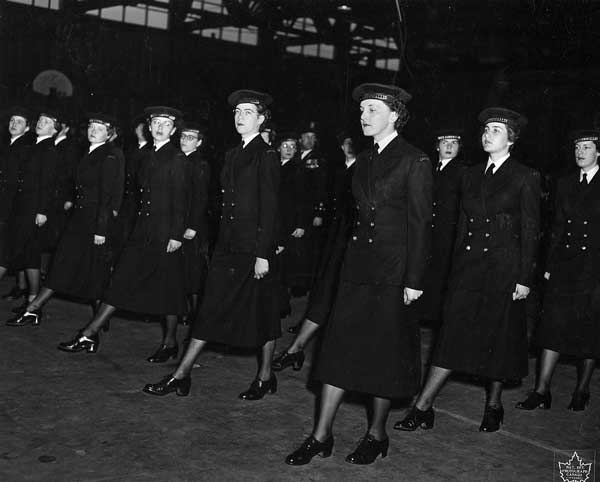Cold War Wrens
1951-68
1951-68
Bonar A. (Sandy) Gow
The last of the Second World War Wrens were discharged in early 1946 and the Women’s Royal Canadian Naval Service (WRCNS) was disbanded shortly thereafter. That event did not mark the end of a need for women in the Royal Canadian Navy (RCN); in light of the Cold War and Korean War, in May, 1951 Parliament authorized the creation of a Wrens’ division in the RCN (Reserve).
Women entered the RCN(R) on Continuous Naval Duty (CND) and their complement was not to exceed 500 officers and Wrens. Unlike the women who entered between 1942 and 1946, they were no longer a separate entity; they were fully-fledged members of the Reserve, though not the RCN.
Recruiting commenced in July, 1951 with a goal of 150 women. New Entry Training would take place in Conestoga Barracks, HMCS Cornwallis. In 1954 a seasoned Second World War officer, Commander Isabel Macneill, was appointed Staff Officer (Wrens) to the Chief of Naval Personnel.
Their Reservist status was altered from February, 1955, when approval was received to classify Wrens as members of the permanent force of the RCN.
In keeping with the established RCN practice for dealing with reservist sailors transferring to the permanent force, the Non-Commissioned Officers (NCOs) were reduced one rank, such that a Wren PO became a Leading Wren, even though she had been serving on CND. This reduction in rank was based on the idea that reservists mustered only once or possibly twice a week for a few hours, and therefore did not have the accumulated time in rank to qualify for promotion. However, these Wrens were serving on a full-time basis, and those that were demoted were disappointed by this move.

Putting their best feet forward – Wrens perform a slow march at their passing out ceremony at CONESTOGA I, November 01, 1951. In the front row, left to right, are Wrens Wright, Guckes, McKinley, Patterson, Day and Schmidt.
This legislation marked the first time in the Commonwealth navies that women were integrated into the permanent force and that Wren officers were permitted to wear gold braid with the executive curl on their lower sleeves to signify their rank. This new generation of permanent force Wrens would be found serving ashore in numbers in Halifax, Esquimalt, Coverdale (NB), Shelburne (NS), Cornwallis (NS) and Ottawa, as well as several smaller naval divisions and shore establishments across Canada.
By the time their numbers peaked in the early 1960s, there were over 30 officers and 175 non-commissioned Wrens, with the latter receiving the same base pay as men serving in the same ranks and trades, and entitled to receive the same pension benefits.
The trades open to women in this period largely reflected Canadian society’s views of women in that most, but not all, were found in non-technical areas and the Navy’s Supply (Writers, Stores) and Communications (Radio) branches, as well as in Submarine Detection at Shelburne or in the Medical branch, especially from the late 1950s onwards.
Wrens, as a distinct entity within the RCN, ceased to exist, as did the RCN, on 1 February, 1968, when the Canadian Forces Reorganization Act came into effect. Their navy blue uniforms were eventually replaced by an olive green creation which was to be worn by all women in the Canadian Armed Forces (CAF). They were now to be referred to as “Servicewomen”, fully integrated within the CAF, but still not entitled to serve at sea. That would come later.
Bonar A. (Sandy) Gow is Professor Emeritus of History, Concordia University College of Alberta, Edmonton. He is currently writing a book about life below decks, based on many years of research and extensive interviews. His research to date has involved interviews with 325 men and women who served in the Navy (RCN, RCNVR, and Wrens) in the lower deck.
He is still searching for those who, before 1970, were in the Sonar, Fire Control, Electrical and Electronics trades, and at the same time reading the publications on a wide range of topics concerning the RCN from 1910 until 1970.
Articles
Hours
7 Days a Week: 10:00 am – 3:30 pm
Monday to Friday: 10:00 am – 3:30 pm
Hours
Monday to Friday: 8:00 am – 4:00 pm
To confirm if we are open, please call (250) 363-5655 or (250) 363-4312
Naval & Military Museum
Info@NavalAndMilitaryMuseum.org
CFB ESQUIMALT NAVAL & MILITARY MUSEUM
PO Box 17000 Stn Forces
Victoria, BC V9A 7N2